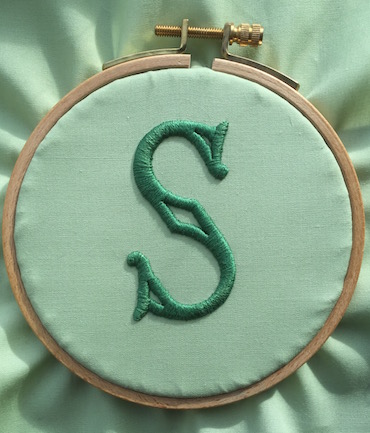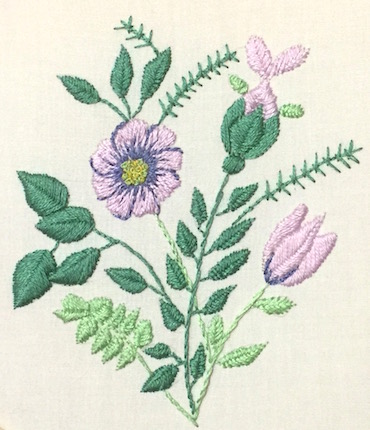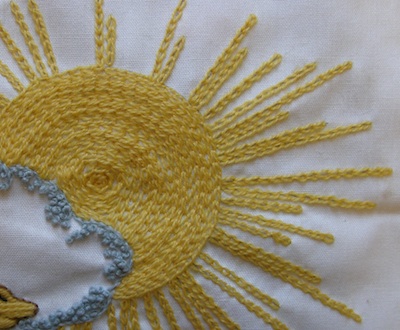- Home
- Embroidery Stitches
3 Embroidery Stitches for Small Embroidered Flowers
Flowers, with their vibrant colours and delicate petals, have long been a symbol of beauty and vitality. Embroidery stitches can capture the essence of these blossoms, but have you ever wondered how?
These intricate and versatile techniques are like magic wands, transforming ordinary fabric into a garden of blooming flowers.
With just a needle, thread, and a bit of brain power, you can bring these floral wonders to life, adding texture and depth to your projects.
So, whether you're stitching a bouquet on a pillowcase or embellishing a dress with dainty petals, these simple embroidery stitches are the secret ingredient that will make your creations blossom with beauty.
As you explore the art of embroidery, you'll discover a treasure trove of stitch techniques that can breathe life into your creations. Among these are the lazy daisy stitch, French knot, and fly stitch.
Once you have learned these basic stitches you can combine them to add variety to your projects.
You will find links to more stitches in the stitch index.
Detached chain embroidery stitches
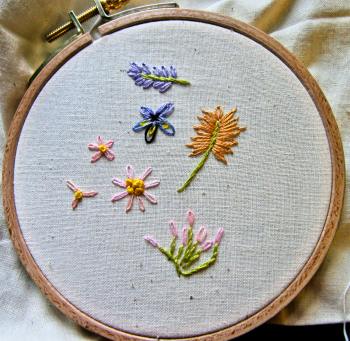
Let’s start with one of the most common embroidery stitches, the detached chain, a stitch that forms delicate petals that dance with grace and charm. This is also known as the lazy daisy stitch.
You can arrange five chain stitches into a flower shape with all the points touching in the center.
Chain stitch embroidery is easy to add to any embroidery pattern without a printed outline.
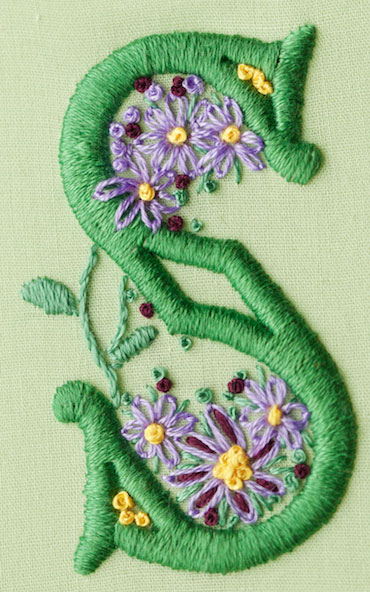
You can also use a detached chain stitch as a complete flower on a stem. Grouped together, they can resemble a bunch of tulips.
Consider embroidering flowers on both sides of a central stem to make a sprig of lavender or an ear of corn.
You can work one detached chain stitch inside another using a different coloured embroidery floss. You can see this in the photo above, inside the bottom curve of the letter. There is a separate tutorial on how to work the padded satin stitch letter.
For something a little different, look at my lazy daisy strawberry tutorial.

French knots for tiny embroidered flowers
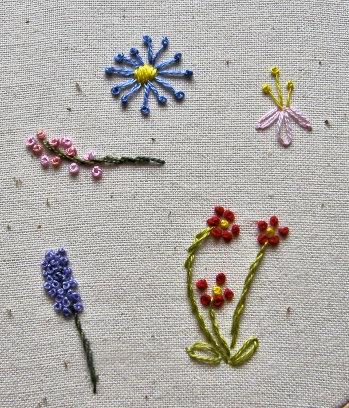
With just a tiny French knot, you can create a focal point that mesmerises the eye. It's like placing a delicate jewel in the heart of your flower, adding an element of surprise and wonder. This stitch not only serves as the heart of the flowers, but we can also use them in various ways to create the flowers themselves
Full instructions along with a video are on my main stitch a French knot page.
One french knot will work for the smallest flower in a design. Put four or five together in a ring, with a central knot in a different colour of embroidery floss and you have forget-me-knots or other small flowers.
Place them randomly along a stem or branch, and you have tiny blossoms or rosebuds.
Mass them together around a stem and you can produce flowers such as bluebells or grape hyacinths.
A variation on the normal French knot embroidery stitches are French knots on stalks. These can serve for both the stamens and the flower itself.
Arranged in a circle with the knots to the outside you end up with a passable representation of an aster.
We can use a combination of stitches to embroider flowers.
For the photo, I utilized detached chains to create petals and leaves, along with stem stitches for stalks and French knots.
So at this point we have learned how to sew a flower using two (no three!) basic embroidery stitches. Simple so far?
Fly stitch flowers and leaves
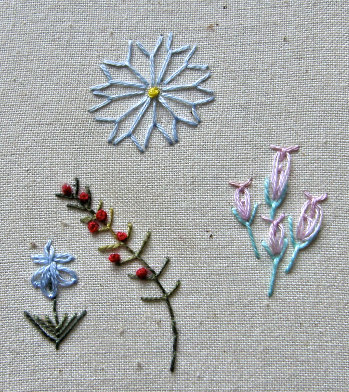
Let's add another to our library of embroidery stitches, this time Fly Stitch.
I commonly use this for the greenery in a floral embroidery. It makes wonderful calyx for detached chain rosebuds. You could also add a fly stitch to the tip of the chain for added effect.
To create a fly stitch, make two straight stitches. After the first stitch, bring the needle back up through the fabric close by and slip it under the previous stitch. Take the needle back through the fabric pulling the first stitch into a V shape.
The tie-down stitch. which can be of any length transforms your work into a Y shape. A short tie-down stitch is less visible, while a longer one can create a stalk for your flower. A pretty versatile stitch don't you think?
Create an embroidered flower by arranging long-tailed fly stitches in a circular pattern with the tails meeting at the center. Space the stitches apart and you end up with a dandelion clock.
Why not vary the size of the fly stitches themselves and enclose each one in a bigger stitch to create the leaves at the base of a plant. Add a backstitched stem and pop a lazy daisy flower at the top.
Or create a spiky branch covered with berries by chaining fly stitches together for the length of the branch. Then add French knots for the berries.
Time to get stitching!
With a little practice and creativity, embroidery stitches can transform your fabric into a colourful garden, allowing you to express your love for flowers in a truly artistic way.
Now that you have mastered the art of floral embroidery with stitches like the lazy daisy stitch, French knot, and fly stitch, it's time to add even more intricate details to your creations. With these stitches, your embroidery will capture the smallest details that make flowers truly enchanting.
Dive deeper into the world of embroidery and discover additional stitches like the bullion knot and seed stitch.
Now you have three (actually four) simple embroidery stitches you can use to add small flowers to your embroidery projects.
Give it a go and see what varieties you can come up with. Don't worry about getting things perfect, just have fun creating.
